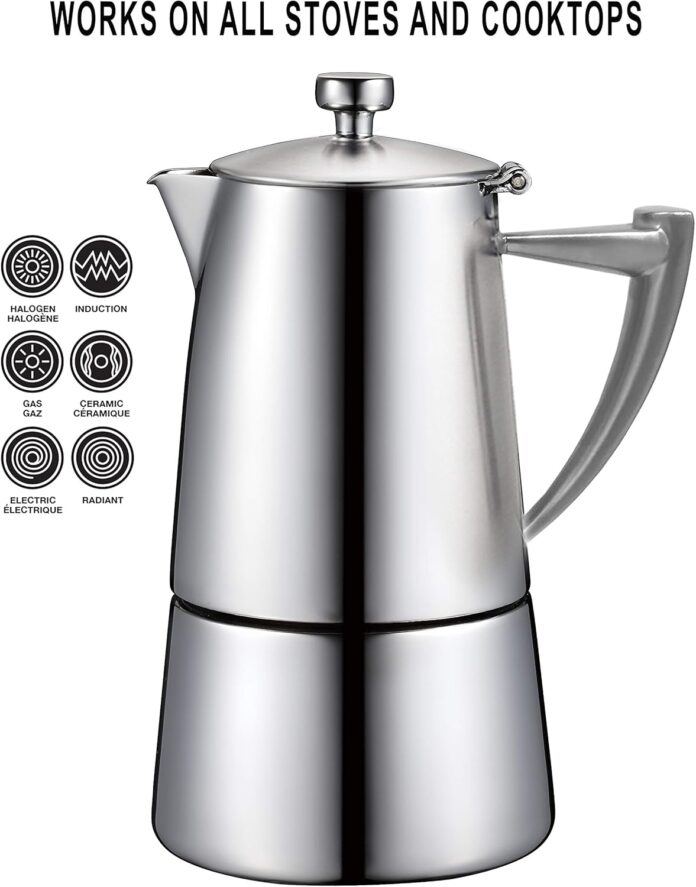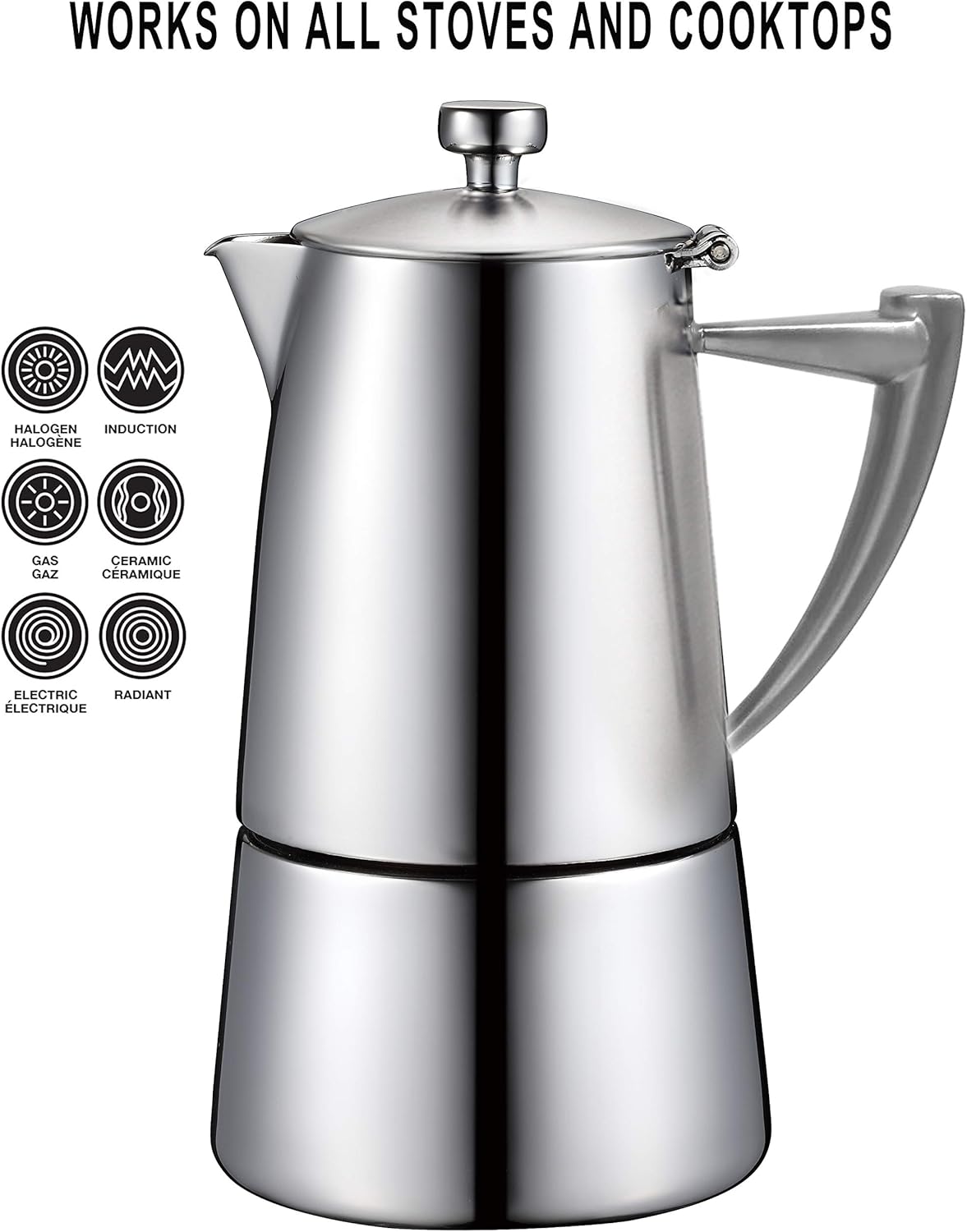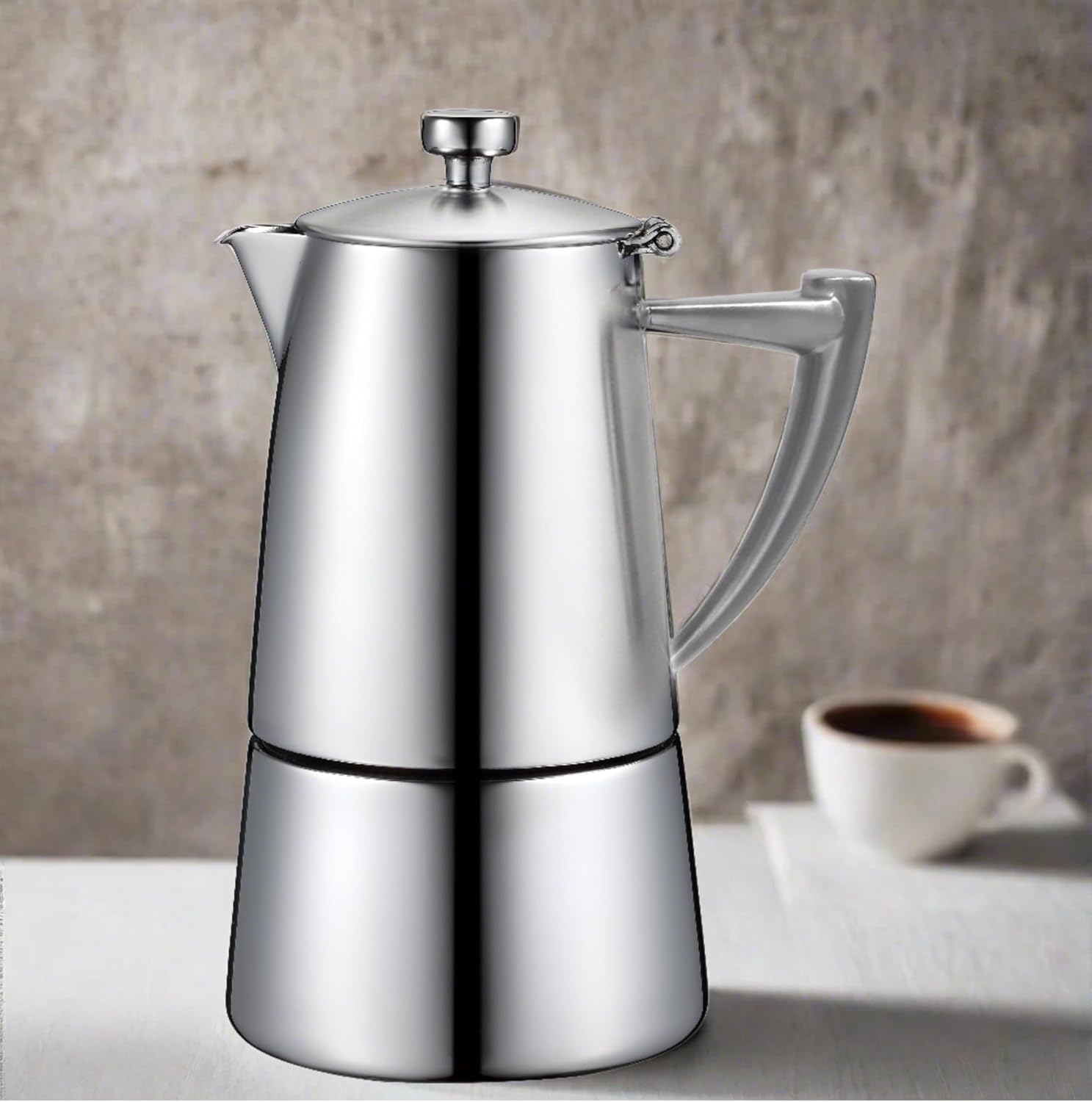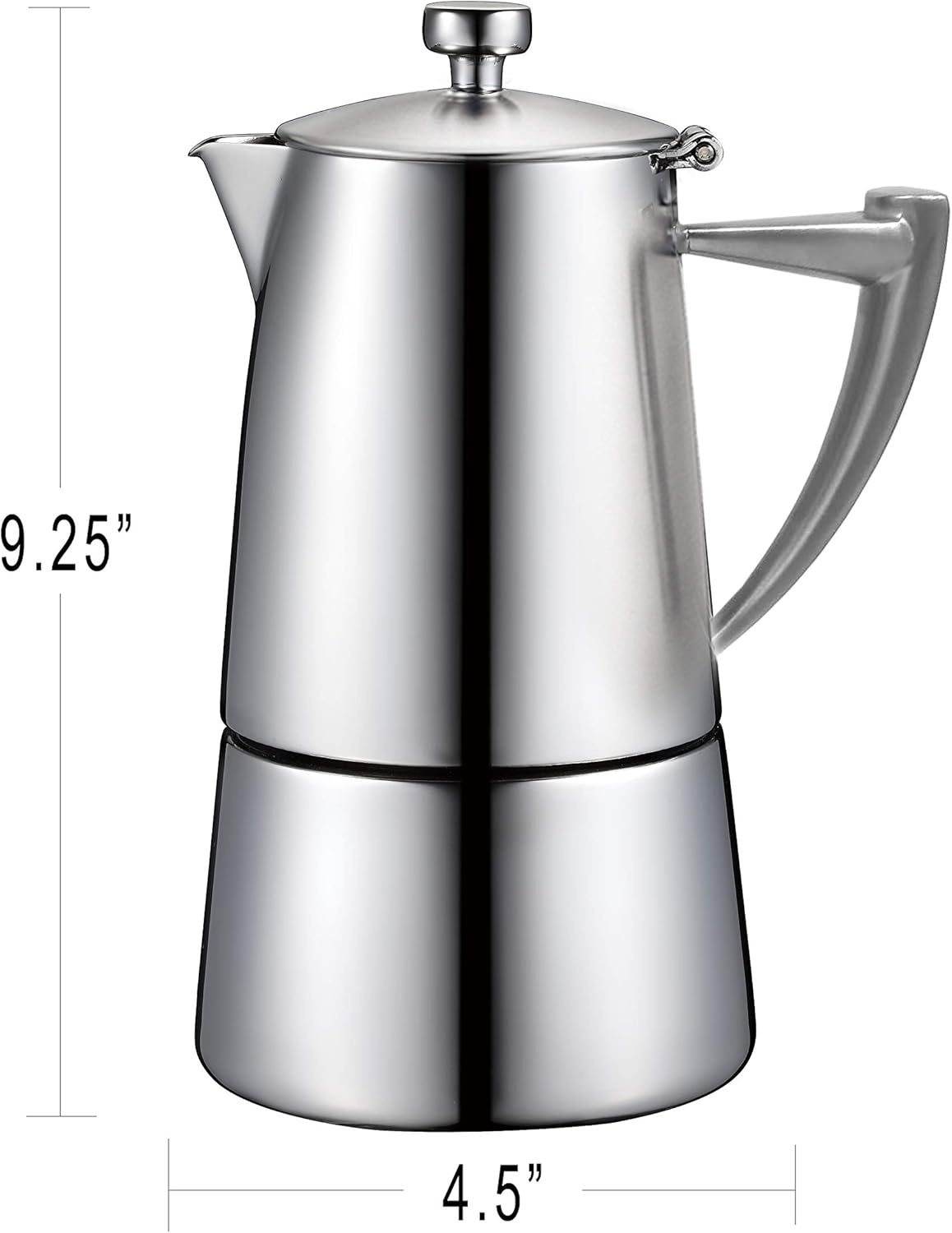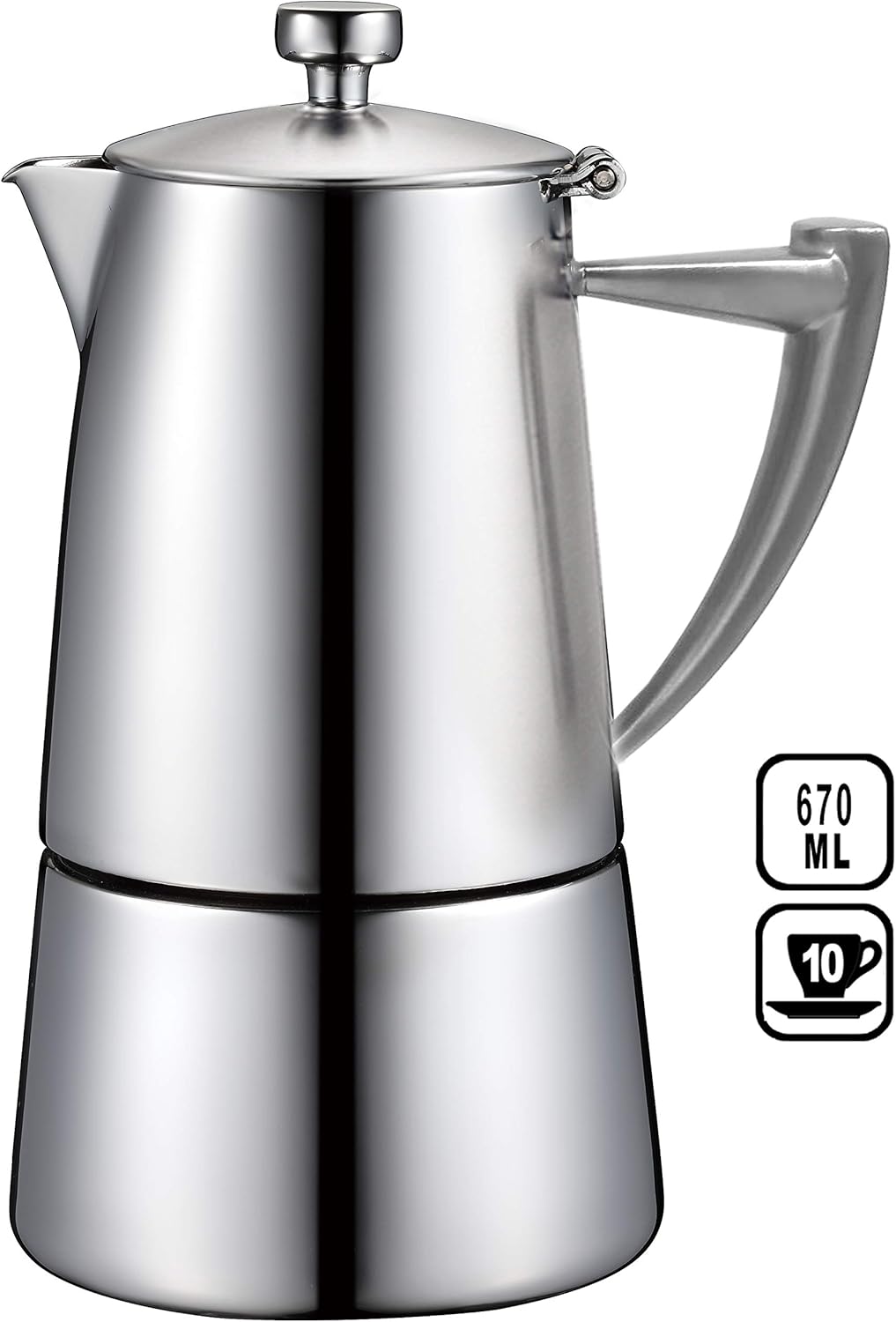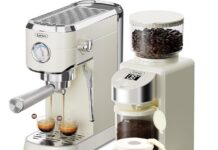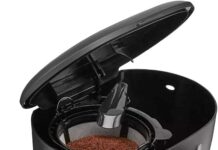Are we ready to see whether the CUISINOX Roma Satin Stainless Steel Moka Pot Stovetop Espresso Maker, 10-Cup is the right addition to our kitchen?
This image is property of Amazon.com.
First impressions
We immediately like how the CUISINOX Roma Satin Stainless Steel Moka Pot Stovetop Espresso Maker, 10-Cup looks and feels. The satin finish on 18/10 stainless steel gives it a modern but timeless appearance, and it feels sturdy in our hands — not flimsy like some lightweight aluminum moka pots.
We also appreciate knowing that there is no coating anywhere on the unit, which reassures us about durability and safety over long-term use. The included extra gasket is a thoughtful touch that shows the manufacturer anticipates the most common wear item and helps us keep the pot working without immediate replacement parts shopping.
Design and build quality
We notice the 18/10 stainless steel construction is a key selling point, offering corrosion resistance, structural strength, and a polished look that holds up to regular kitchen use. The satin finish hides fingerprints and light scratches better than mirror polish, which helps the pot maintain a clean appearance between washes.
The build feels well-engineered: a secure screw-top assembly, a solid handle (check for heat resistance when new), and an induction-ready base. The lack of coatings means we don’t have to worry about layer degradation, flaking, or potential nonstick chemicals coming into contact with our coffee.
Measurements and capacity
We like having clear numbers to match expectations. The product dimensions and how the manufacturer defines “10-cup” are especially useful when planning how much coffee we’ll actually get for a group.
| Specification | Detail |
|---|---|
| Product name | CUISINOX Roma Satin Stainless Steel Moka Pot Stovetop Espresso Maker, 10-Cup |
| Material | Satin finish 18/10 stainless steel |
| Capacity | 10 “cups” (based on 1.5 oz cups) ≈ ~15 ounces total |
| Base diameter | 4.5 inches |
| Height | 9.25 inches |
| Compatibility | Induction base — compatible with all stovetop surfaces |
| Included extras | 1 extra gasket |
| Coating | No coating anywhere |
We find it helpful to remember that the “cup” size referenced here is the classic moka cup measure of about 1.5 ounces, so the 10-cup model yields approximately 15 ounces of brewed coffee. That’s usually enough for three to five typical mugs, depending on how much coffee we pour.
CUISINOX Roma Satin Stainless Steel Moka Pot Stovetop Espresso Maker, 10-Cup
Performance and brew quality
We’re mindful that a stovetop moka pot produces a strong, concentrated coffee that resembles espresso in intensity but doesn’t reach the same pressure levels as an espresso machine. The CUISINOX Roma Moka Pot consistently delivers a rich, full-bodied cup with good clarity when we follow proper technique.
Because the unit is stainless steel with a solid induction base, heat distribution is more even than many thin aluminum pots, which helps extraction consistency. When we control the heat and grind size, the coffee can be sweet, bold, and less metallic than some aluminum alternatives.
Heat control and stovetop compatibility
We appreciate that the induction base makes this moka pot versatile across gas, electric, ceramic, and induction stovetops. The 4.5-inch base diameter is practical for many burner sizes, though on very small burners the pot may overhang slightly — and on very large burners you’ll want to use lower heat for best results.
Induction compatibility means we can use this pot even if we have a modern induction range. We’ve found that keeping heat low-to-medium produces the best extraction; high heat tends to rush the process and produce a harsher taste.
Grind size and coffee dosing
We always pay close attention to grind size when using a moka pot. For the CUISINOX Roma, we recommend a fine-to-medium-fine grind — finer than drip but not as fine as espresso. If the grind is too coarse the coffee will taste weak; if it’s too fine, the brew can become bitter and might slow or block the extraction.
Because the manufacturer’s “cup” is 1.5 ounces, we dose accordingly: for a full 10-cup pot (approx 15 oz brewed), use around 20–25 grams of coffee per 1.5–2 ounces of intended beverage when dialing in to taste. We avoid tamping the coffee into the basket; simply level it off gently to allow water to pass through the grounds.
Brew steps and technique
We prefer a simple, repeatable routine that yields consistent results:
- Preheat water to just below boiling to shorten time on the stove and reduce metallic flavors.
- Fill the lower chamber up to the safety valve with hot water (not above it).
- Fill the filter basket with the proper grind and level it off gently. No tamping.
- Screw the top and bottom together securely, ensuring the gasket sits properly.
- Place on a low-to-medium heat source. Keep the lid open slightly or closed depending on preference; watching the flow helps us stop at the right time.
- When the coffee begins to spurt and fill the top chamber, we reduce heat and remove the pot just as the flow turns to a sputter and the liquid becomes frothy to avoid burning flavors.
- Stir the top chamber gently to blend the first and last pours, then serve.
We’ve found this method limits over-extraction and bitterness while preserving the rich character moka pots are known for.
Brew time and yield estimates
In our experience, brewing takes about 5–10 minutes total, depending on starting water temperature and burner power. Using preheated water shortens that to around 4–6 minutes. For the full 10-cup model, expect roughly 15 ounces of concentrated coffee. If we prefer milder drinks, we stretch that into longer cups or add hot water/milk for Americanos or lattes.
Cleaning and maintenance
We agree that maintenance is straightforward, but there are a few best practices to keep the pot functioning and tasting great.
We rinse the pot after each use with warm water, avoiding detergents that can cling to stainless steel and affect flavor over time. Since the CUISINOX Roma has no coating, it’s safe from flaking, but food-safe cleaning still matters to preserve the gasket and metal finish.
Disassembly and parts care
We recommend disassembling the pot occasionally to check the gasket and filter plate for coffee buildup. The extra gasket included is helpful; we retain it for when the original shows visible wear or loses elasticity.
Scrub the basket and filter plate gently with a soft brush to remove trapped grounds. The safety valve should remain unobstructed; if it becomes clogged, clean it carefully (following manufacturer guidance or using a small pin to clear debris while ensuring no damage is done).
Dishwasher and cleaning agents
Although stainless steel is often labeled dishwasher-safe, we prefer hand washing for this moka pot to protect the gasket and maintain the satin finish. Dishwasher detergents and the heat cycle can accelerate gasket wear and may dull the finish over many cycles. For regular cleaning, hot water and a soft sponge are plenty.
If we need to remove stubborn coffee oil buildup, we use a mild baking soda paste or a vinegar soak followed by thorough rinsing. We avoid bleach, abrasive scouring pads, and harsh chemical cleaners.
Durability and parts replacement
We appreciate the extra gasket included in the box — it acknowledges the most commonly replaced part. Gaskets and filter plates are generally available from CUISINOX or third-party sellers if we need replacements later.
Because there’s no coating, we avoid worries about peeling or flaking. The stainless steel construction resists dents and corrosion better than aluminum, especially on induction cooktops where temperatures and handling may be a little different.
Safety considerations
We always check the safety valve before use and never overfill above the valve. If the safety valve shows signs of corrosion or obstruction, replace it or stop using the pot until it’s fixed. Also, handle the pot with heat-resistant grips or a towel during and right after brewing, as the metal retains heat.
This image is property of Amazon.com.
Pros and cons
We’ve broken down the primary advantages and trade-offs to help decide whether this moka pot fits our needs.
Pros:
- Robust 18/10 stainless steel construction that resists rust and dents.
- Induction-compatible base works on all stovetops.
- Attractive satin finish that hides fingerprints and light scratches.
- No coating anywhere, reducing long-term chemical concerns.
- Includes an extra gasket for quick replacement.
- Produces a rich, concentrated coffee similar to stovetop espresso.
Cons:
- Heavier than aluminum moka pots, which may matter for portability.
- Not a pressurized espresso machine; won’t produce true espresso crema.
- Requires some technique to avoid bitterness or sputtering.
- Hand washing recommended to preserve gasket and finish.
We find the advantages of durability and stovetop compatibility outweigh the cons for most home users who want a reliable, long-lasting moka pot.
Comparison with aluminum moka pots and small espresso machines
We often consider whether to choose an aluminum classic (like a Bialetti) or a stainless steel version such as the CUISINOX Roma. We also weigh stovetop moka pots against compact espresso machines.
Stainless steel vs aluminum moka pots
Stainless steel offers greater durability and is induction-compatible, while aluminum is lighter and often more affordable. We prefer stainless steel for longevity and neutral flavor profile; aluminum can impart a metallic taste in some cases, especially as it ages or with acidic coffees.
Stainless steel is generally dishwasher-safe in some models, but we still hand wash to preserve gaskets. Aluminum performs well but requires more careful drying to avoid oxidation; anodized aluminum variants are an exception but still lack induction compatibility in many cases.
Moka pot vs small espresso machine
A stovetop moka pot like the CUISINOX Roma yields concentrated, flavorful coffee with lower cost and simpler maintenance than an espresso machine. However, it doesn’t reach the 9+ bar pressure needed for true espresso or the same crema quality. If we crave barista-style espresso shots and milk texturing, an espresso machine is preferable.
For those who appreciate strong coffee without the complexity or expense of a machine, the CUISINOX Roma is an excellent compromise. It’s also more portable and quieter than a full machine.
This image is property of Amazon.com.
Who this moka pot is best for
We think the CUISINOX Roma is ideal for a few distinct user types:
- Households that want a sturdy, attractive moka pot for daily use.
- People with induction stoves who need stainless steel compatibility.
- Coffee lovers who enjoy strong, concentrated coffee without buying an espresso machine.
- Those looking for a durable kitchen item that will last several years.
- Gift buyers who want a premium-feeling alternative to entry-level aluminum pots.
If we frequently need single shots of espresso-quality crema or want automatic milk frothing, we might look at dedicated espresso machines instead. But for reliable stovetop coffee, the CUISINOX Roma fits most needs very well.
Unboxing and what’s included
We like unboxing items with clear expectations. The package typically contains:
- CUISINOX Roma Satin Stainless Steel Moka Pot, 10-Cup (assembled)
- 1 extra gasket
- Manufacturer instructions/warranty information (check packaging)
We recommend retaining the packaging and instruction leaflet until we’ve successfully brewed several batches and become familiar with the assembly and cleaning routine.
This image is property of Amazon.com.
Price and value
We evaluate value by assessing materials, build, versatility (induction compatibility), and extras like the spare gasket. The CUISINOX Roma offers a durable stainless steel body and thoughtful accessories that justify a mid-range price point.
Considering long-term ownership, stainless steel usually outlasts aluminum and resists dents and corrosion. The induction-ready base makes it future-proof for many kitchens, so we see strong value if we intend to use it regularly.
Brewing recipes and variations
We enjoy experimenting with moka-brewed coffee. Here are a few simple recipes and variations we often use with the CUISINOX Roma:
- Classic moka: Use the standard grind and method described earlier, serve straight into small cups for a strong, sweet, and concentrated drink.
- Moka Americano: Brew full pot, then add hot water to taste for a larger, milder cup. It keeps the moka character but lengthens it.
- Moka latte: Fill one-third to half the cup with steamed milk and pour concentrated moka coffee over it. We sometimes froth milk separately for a creamier texture.
- Café con leche: Equal parts brewed moka coffee and hot milk make a comforting, milky beverage for breakfast.
- Iced moka: Brew strongly, cool slightly, pour over ice, and add cold milk for a refreshing cold drink.
We’ve found that the pot’s concentrated output makes it versatile for milk-based drinks and diluted Americanos alike.
This image is property of Amazon.com.
Troubleshooting and common issues
We’ve encountered and solved several common moka pot issues; knowing them helps us avoid frustration.
- Weak coffee: Likely grind too coarse, underdosing, or water-filled too low. We adjust grind and measure coffee more precisely.
- Bitter or burnt taste: Often from excessive heat or leaving the pot on the burner too long. We reduce heat and remove the pot when the top chamber flow becomes frothy.
- Sputtering or noisy end of brew: Usually indicates emptying of the lower chamber; remove from heat promptly to avoid metallic or burned flavors.
- Leakage at the seal: Check the gasket seating and replace if deformed; included extra gasket helps here.
- Safety valve issues: Never block or force the valve open. If it’s clogged, clean carefully and test before use. Replace if damaged.
We always press the parts together gently and ensure threads are clean to maintain a tight seal without cross-threading.
When things don’t work despite precautions
If we follow best practices and still face problems — persistent leaking, metal fatigue, or issues with the safety valve — we contact CUISINOX customer service or a retailer for warranty help. Retain purchase proof and photos when possible.
Environmental and health considerations
We feel good about the absence of coatings on the CUISINOX Roma; no nonstick layers means fewer concerns about chemical degradation. Stainless steel is recyclable, and the product’s durable construction suggests a long useful life, reducing disposable replacements.
We recommend replacing gaskets and filter plates as needed rather than discarding the entire pot, which extends product life and reduces waste.
How to get the best results every time
We’ve found that a few consistent habits make the biggest difference in brew quality:
- Use fresh, properly roasted coffee and grind it just before brewing.
- Preheat water to reduce time with the pot on the heat source.
- Keep the heat low-to-medium to avoid rushing extraction.
- Never tamp the coffee in the basket; keep it loose and level.
- Clean and dry thoroughly after each use; inspect gaskets regularly.
- Replace gaskets and filter plates when performance declines.
These incremental steps make the difference between a decent cup and an excellent one.
Frequently asked questions (FAQ)
We answer the questions we hear most often so other buyers can assess fit quickly.
Q: Is this moka pot safe for induction stovetops?
A: Yes — the CUISINOX Roma has an induction-compatible base and is suitable for use on induction, gas, ceramic, and electric stovetops.
Q: How much coffee does the 10-cup model produce?
A: The manufacturer defines “cup” as 1.5 ounces, so a full 10-cup pot yields about 15 ounces of brewed coffee.
Q: Is the pot dishwasher safe?
A: While stainless steel can be dishwasher-safe, we recommend hand washing to preserve the gasket and satin finish and to extend the life of the parts.
Q: Does it produce real espresso?
A: It produces a concentrated coffee similar to espresso in intensity, but not true espresso with the same pressure or crema as a pump-driven machine.
Q: What do we get in the box?
A: The pot itself and one extra gasket are included. Check packaging for any printed instructions or warranty details.
Final verdict
We find the CUISINOX Roma Satin Stainless Steel Moka Pot Stovetop Espresso Maker, 10-Cup to be a well-built, versatile option for anyone seeking robust stovetop coffee with the convenience of induction compatibility. Its 18/10 stainless steel construction, satin finish, and included spare gasket contribute to a sense of long-term value and practical design.
If we want a durable, attractive moka pot that works on modern stovetops and gives us concentrated, flavorful coffee with a small learning curve, this model is an excellent choice. The trade-offs — manual technique, heavier weight compared to aluminum, and lack of true espresso pressure — are reasonable for the price point and intended use. We recommend it to households that enjoy stovetop coffee and value durability and compatibility with induction cooking.
Disclosure: As an Amazon Associate, I earn from qualifying purchases.


